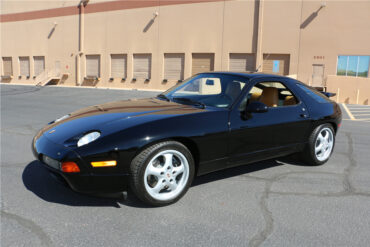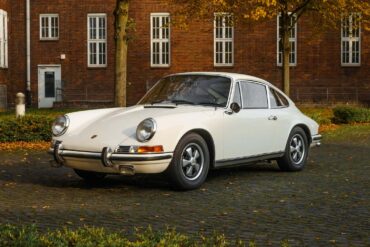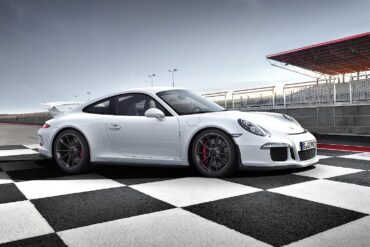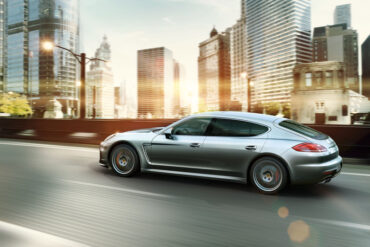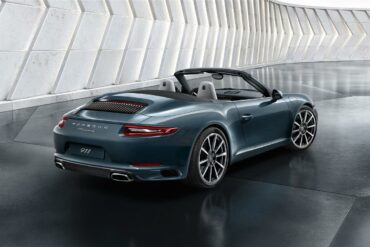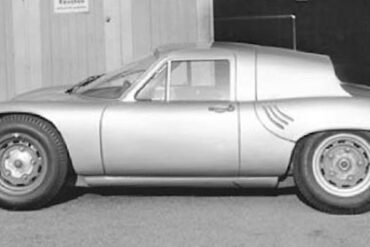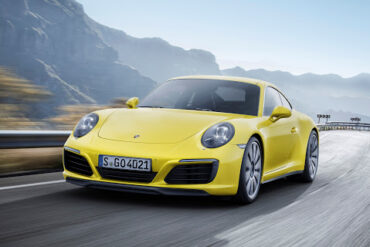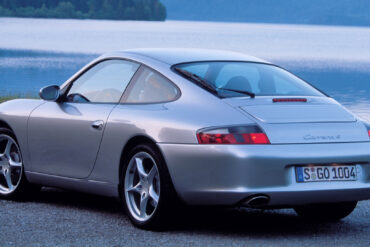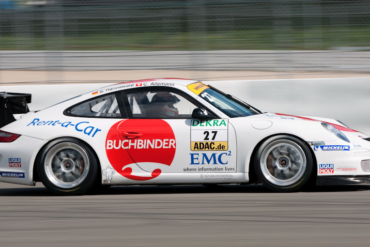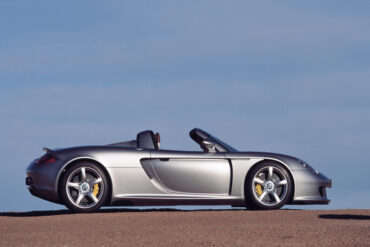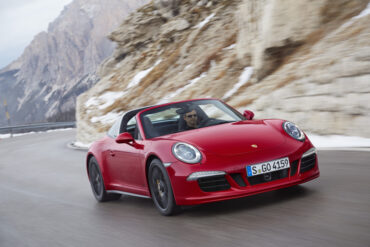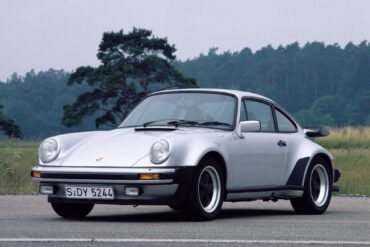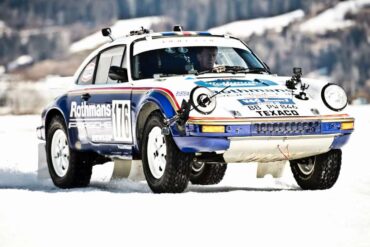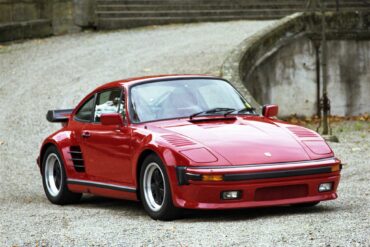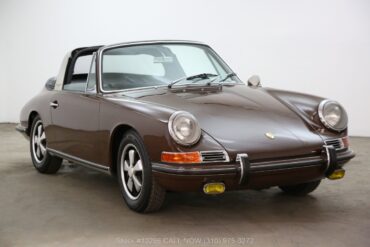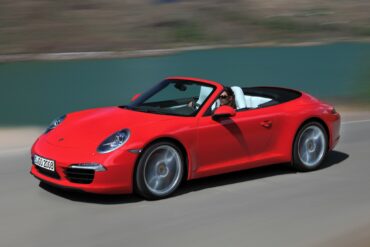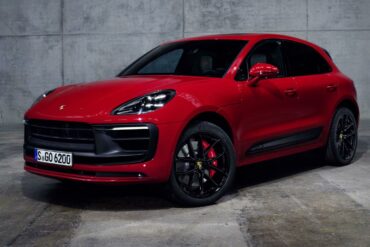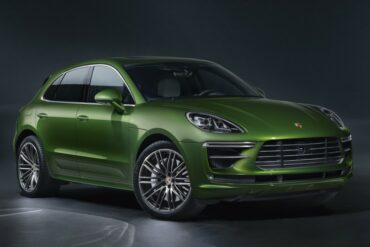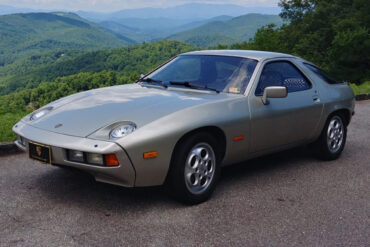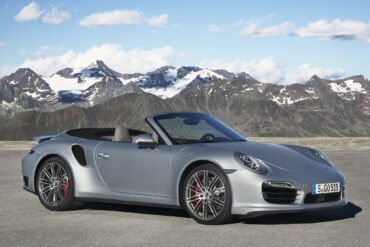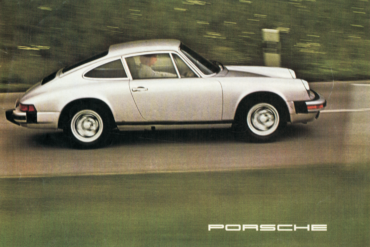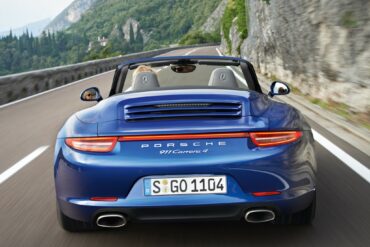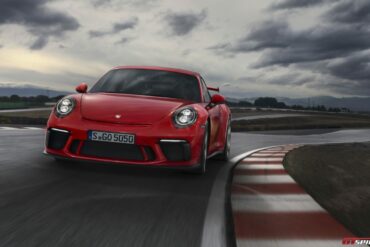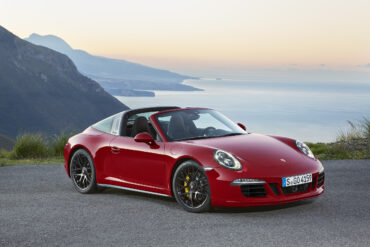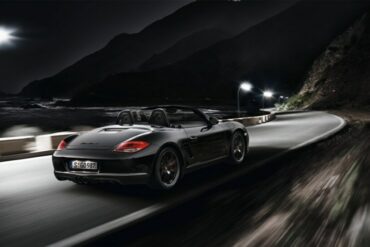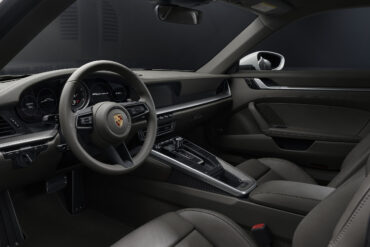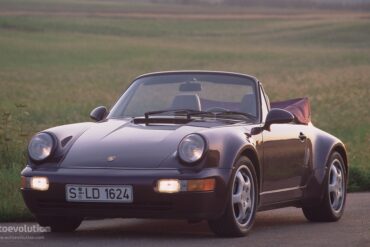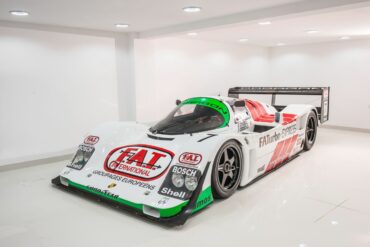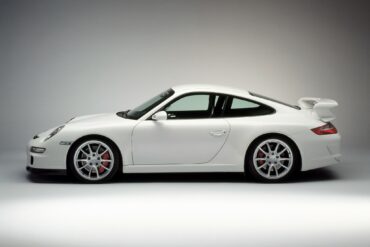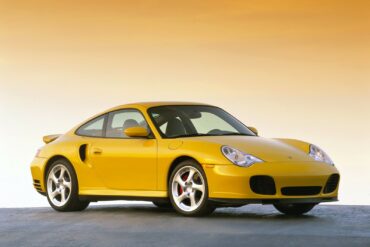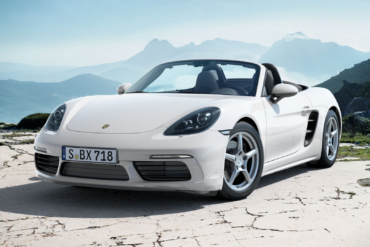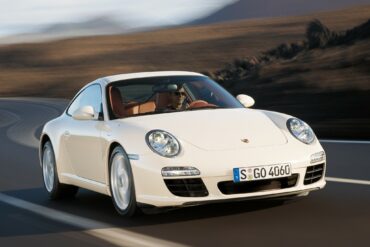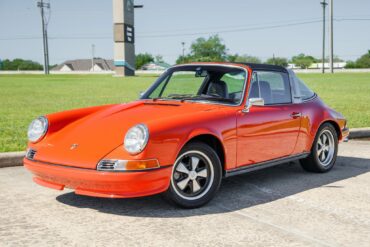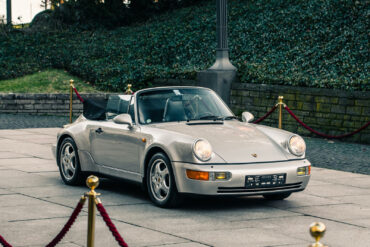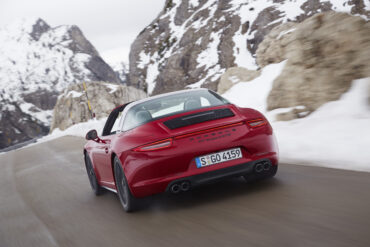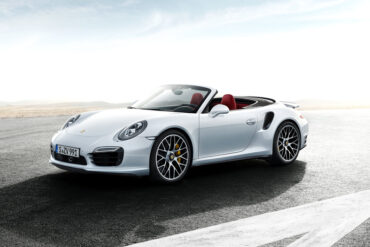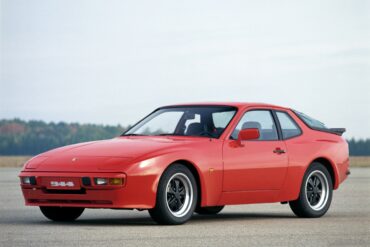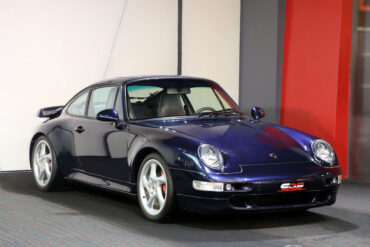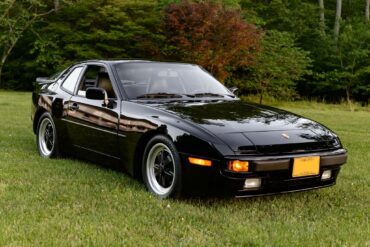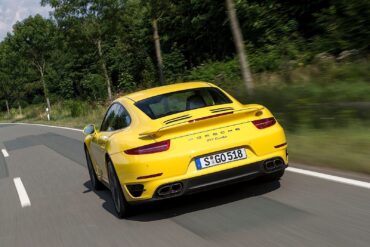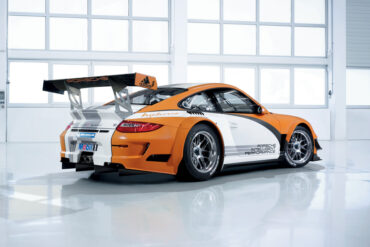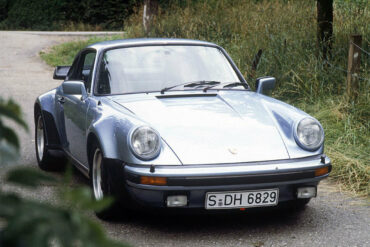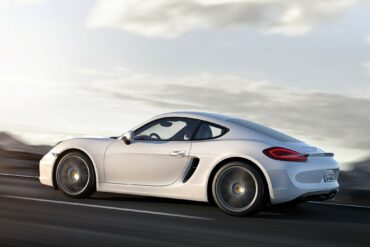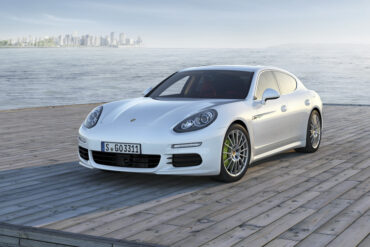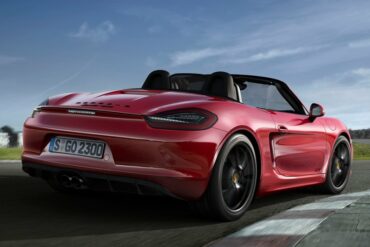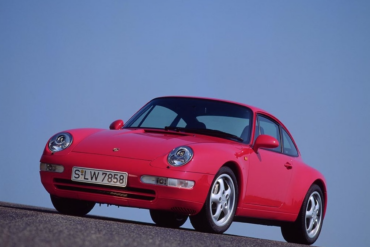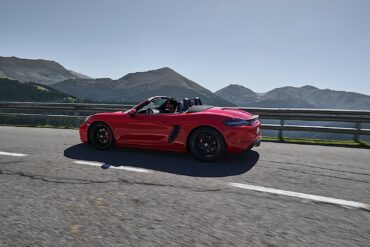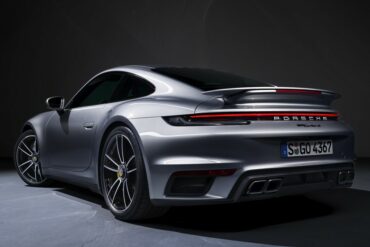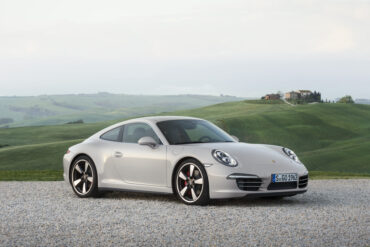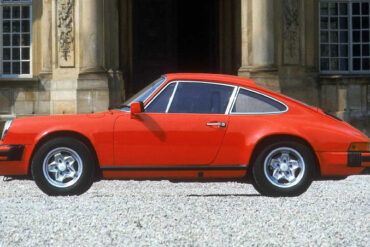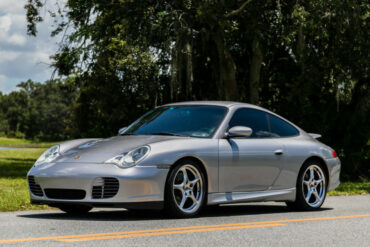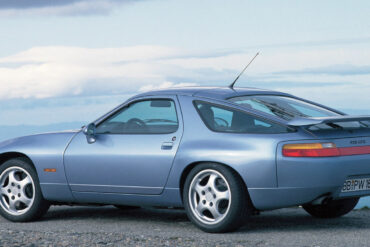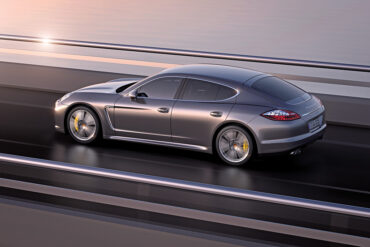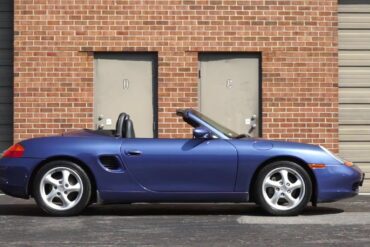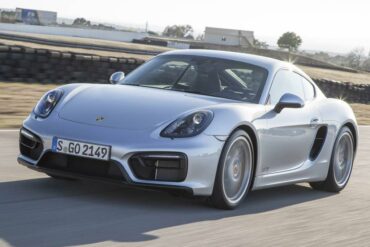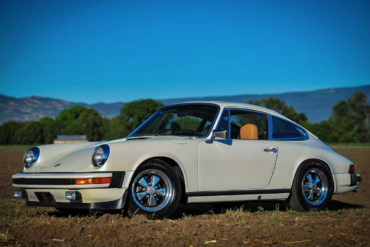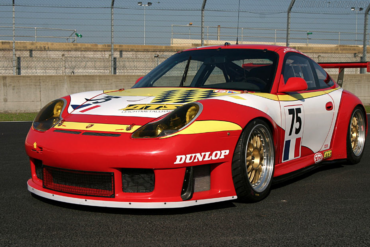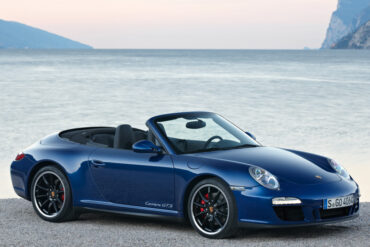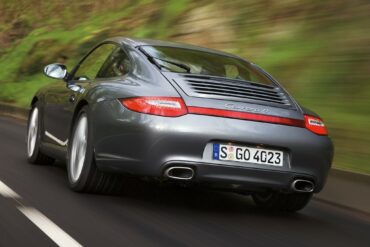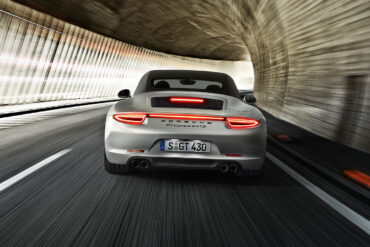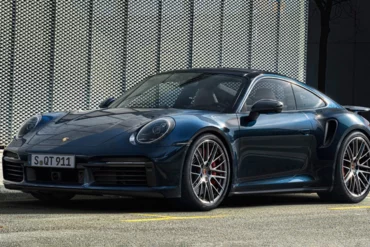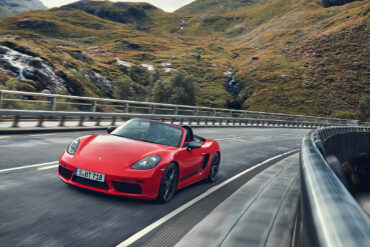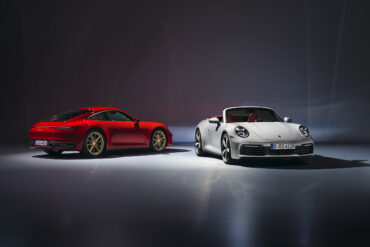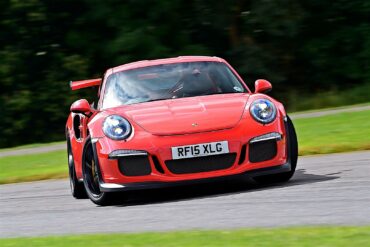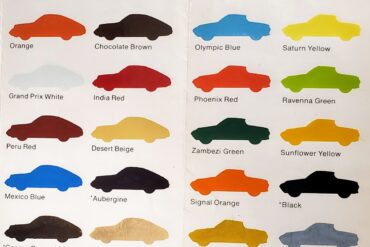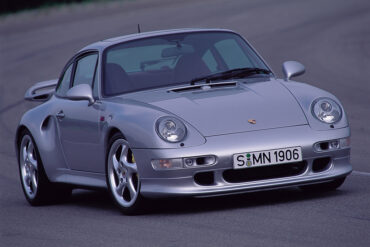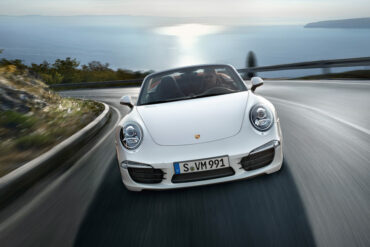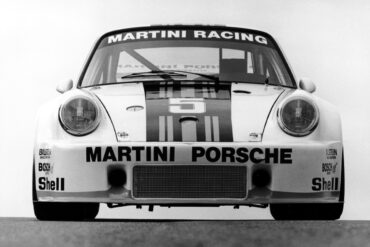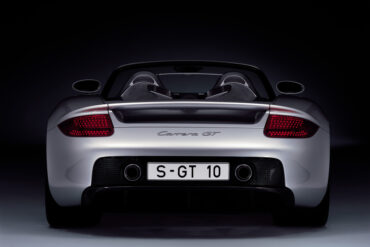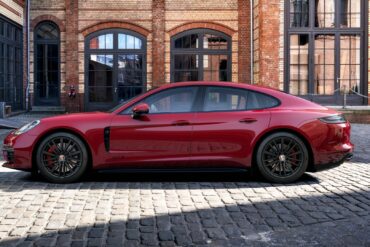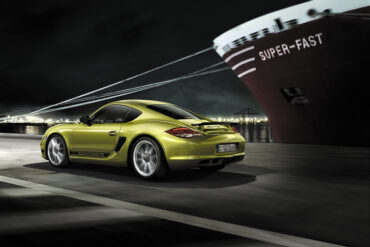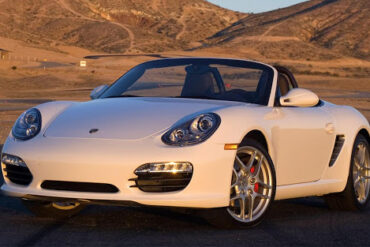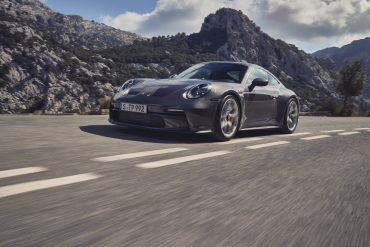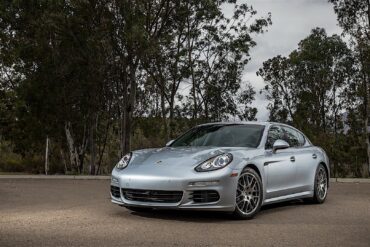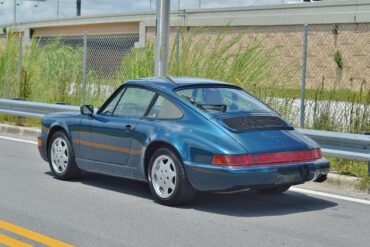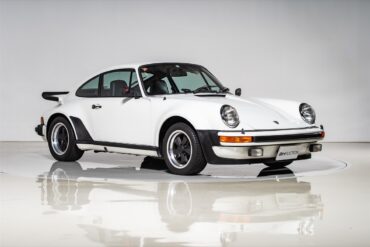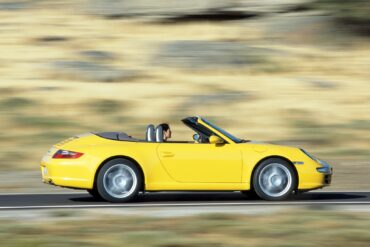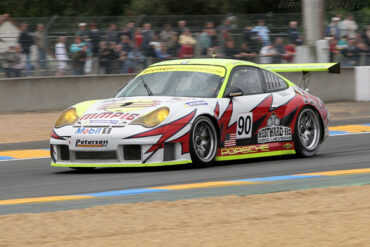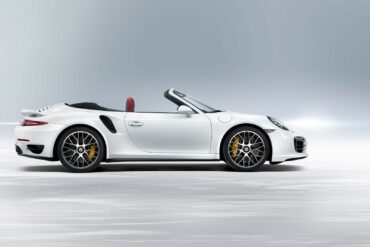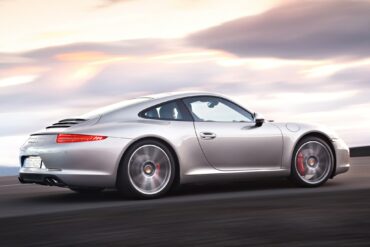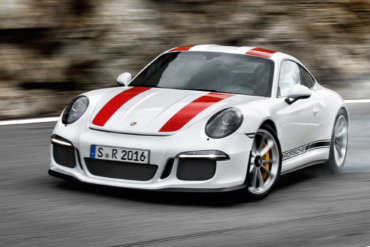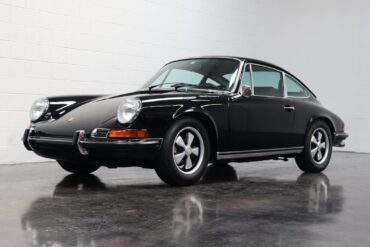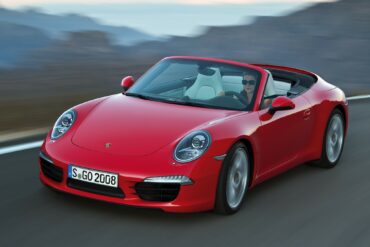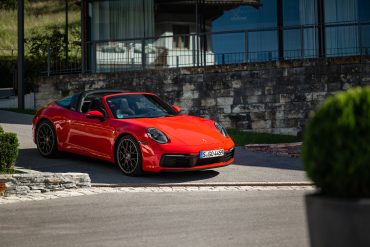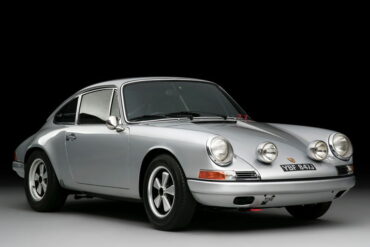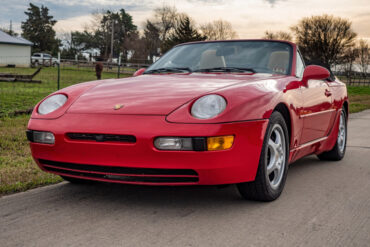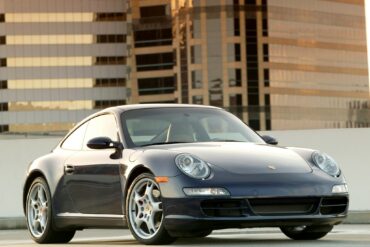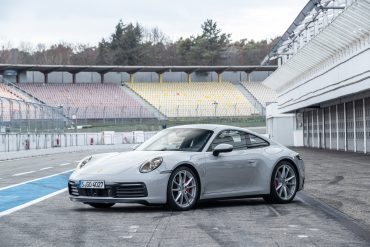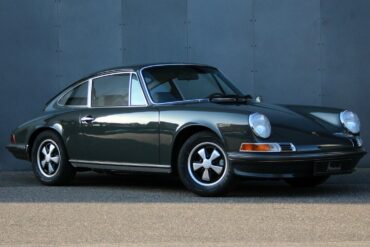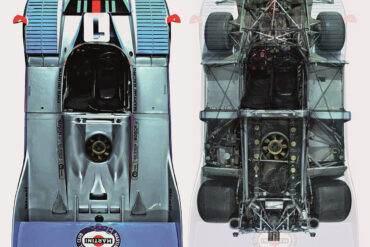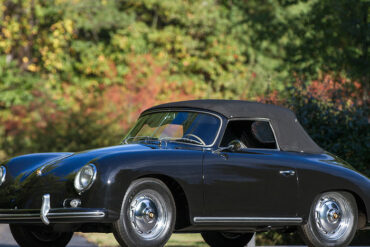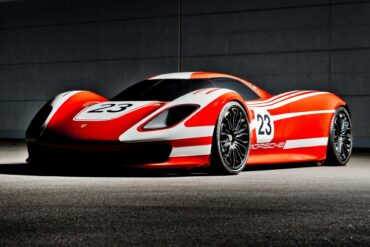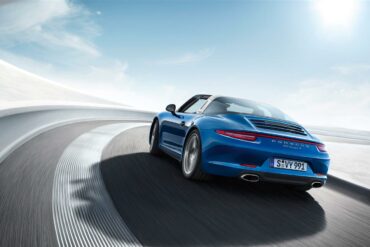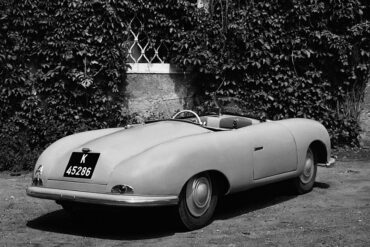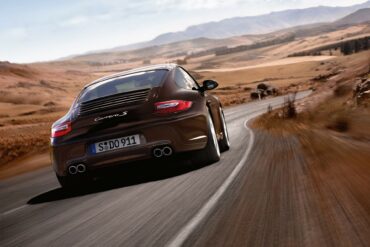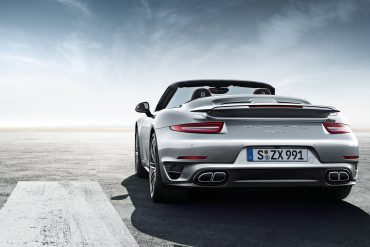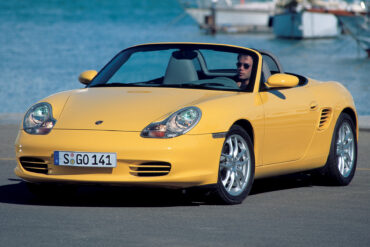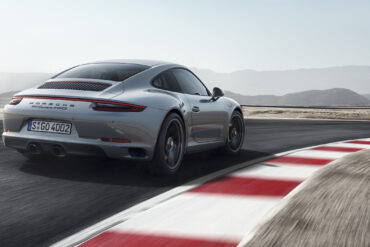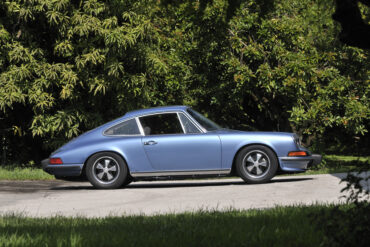Porsche Option Codes – Porsche 928 (1994 Model Year) Looking to decode your 1994 Porsche 928 option codes? Want to...
1970 – 1971 Porsche 911 E Coupe 2.2 (LWB) Technical Specifications Induction Normally-aspirated Cooling Air/oil-cooled Valvetrain Single overhead camshaft Injection...
2015 Porsche 911 GT3 (991) Technical Specifications type Series Production Car released at 2013 Geneva Motor Show built at Stuttgart, Germany...
The big news for 2014 was the introduction of an all-new Panamera Turbo executive model. It featured a 15 cm (5.9”) longer wheelbase than the Turbo. It was built to offer more legroom in the back. Strangely though, it was built especially for the Chinese market, where the long-wheelbase version of a car, any car, was considered an executive car by default. Basically, the Executive Panamera is an excuse for Porsche to elongate a Panamera Turbo by nearly six inches for an extra $19,800. All of the legroom goes to passengers in the back.
2019 Porsche 911 Carrera Cabriolet (991.2) Technical Specifications Engine Engine layout Rear Engine Engine type Boxer, twin-turbo Cylinders 6 Valves per...
The story of the 718 coupé began in 1960 when a customer ordered a one-off design from Karosserie Wendler. The car was built on the Porsche 550 chassis. Front-end design came from the 718 Spyder. The roof and the rear end were unique creations by Wendler. For the Le Mans 24h race in June 1961, Porsche created two 718 RS 61 Coupés. They shared the side view silhouette of the Wendler coupé and the rear end of the 718 Spyder, but the front design was original to the car.
Porsche Option Codes – Porsche 911 (2017 Model Year) Looking to decode your 2017 Porsche 911 option codes? Want to...
Porsche Option Codes – Porsche 911 (2001 Model Year) Looking to decode your 2001 Porsche 911 option codes? Want to...
2008 Porsche 911 GT3 Cup S (997) Technical Specifications Type Racing Car Built at Weissach, Germany Engine Boxer-6 w/Dry Sump Lubrication Displacement...
Porsche Carrera GT Contents Chassis & Handling Design, Styling & Interior Pricing Performance & Specs Model & Pricing Info Suspension...
The Targa 4 GTS gets Porsche’s a powerful non-turbo rear-mounted flat-six engine with 430 bhp @ 7500 rpm and 325 ft lbs of torque from 5750 rpm, driven to all four wheels via Porsche Traction Management. Performance is also enhanced via the standard Sport Chrono package, which provides faster throttle response and more aggressive shift mapping. In addition, the GTS benefits from Porsche Active Suspension Management - Porsche’s proprietary adaptive suspension system with continuously variable dampers. Mechanically, this is the perfect package for a daily 911 that is also performance focused when you need it to be.
Porsche made its first and most significant changes to the 930 for 1978 model year, enlarging the engine bore by 2 mm (0.08 in) to a total displacement of 3,299 cc (3.3 L; 201.3 cu in) and adding an air-to-air intercooler. The suspension benefitted from new anti-roll bars, firmer shocks and larger diameter rear torsion bars. While the increase in displacement increased power output and torque, it also increased the weight of the vehicle, which contributed to a substantial change in the handling and character of the car compared to the Earlier 3.0-Litre Models.
The Porsche 953 ranks as one of the finest off-roaders Porsche has ever made. It was basically a souped-up 911 designed specially to give Porsche an advantage in the 1984 Paris–Dakar Rally. Just a year later, it was replaced by the 959. Despite its brief run, it still managed to make quite the impression. Built around a massively enhanced suspension and a supremely powerful 300 bhp (224 kW), 6-cylinder engine, it showed Porsche knew more than just sportscars.
Slantnosed and based on that of the 935 racecars, with pop-up headlamps. The front spoiler was made deeper in order to accommodate the extra oil cooler, while intakes in the rear wings fed air to the brakes. The larger turbocharger and four-outlet exhaust gave 30bhp of extra power. Porsche began their “special order program” offering a Flachbau option (Slantnose) for the 930 in very limited production. All of this at a cost of nearly 2 times the standard 930S.
1968 Porsche 911 L Targa 2.0 (SWB) Technical Specifications Type Series Production Car Model Years 1968 Built At Germany Body...
2012 Porsche 911 Carrera S Cabriolet (991) Technical Specifications Engine Type Flat 6 Induction Normally-aspirated Cooling Water-cooled Valvetrain Four overhead camshafts,...
Porsche Macan Sales Figures Porsche Macan Sales Numbers (U.S Market) Sales Totals Per Year & Model (coming soon) Sales...
After a one-year hiatus, Porsche brings us a Macan Turbo with more power, more speed, and more standard equipment. It swapped its twin-turbocharged 3.6-liter V-6 for a new twin-turbo 2.9-liter V-6 shared with versions of the larger Cayenne SUV and the Panamera. Porsche claims that it's enough to punt the all-wheel-drive Macan Turbo to 60 mph 0.3 second quicker than before. This is the top of the Macan lineup heap.
1981 Porsche 928 Technical Specifications The Porsche Model 928 was launched in 1977 and was powered by a water-cooled V-8...
2016 Porsche 911 Turbo Cabriolet (991) Technical Specifications Engine layout Rear Engine Engine type Twin Turbo Boxer w/ VTG Cylinders 6...
Porsche 911 Sales Brochures (2nd Generation – G Series) Clearly going back this far, sales catalogs for Porsche cars are...
2015 Porsche 911 Carrera 4 Cabriolet (991) Technical Specifications Engine Type Flat 6 Induction Normally-aspirated Cooling Water-cooled Valvetrain Four overhead camshafts,...
A 911 for the road and track – the new Porsche 911 GT3 Stuttgart. The Porsche 911 GT3 delivers motorsport-like performance,...
On 3 January 2019 the 718 Cayman GT4 Clubsport was unveiled in two variants, Competition and Trackday, with first customer cars delivered to customer teams ahead of the 2019 Roar Before the Rolex 24 Hours at Daytona International Speedway. The race car is powered by a 3.8-litre naturally-aspirated flat-six engine producing 425 PS (419 bhp; 313 kW) at 7,500 rpm and 425 N⋅m (313 lb⋅ft) at 6,600 rpm connected to a 6-speed PDK gearbox. The kerb weight is 1,320 kg (2,910 lb). Both variants feature a welded-in roll cage, a six-point harness and race bucket seat, a selection of body parts made of natural-fibre composite materials and race suspension from the 911 GT3 Cup.
The 911 Targa 4 GTS isn't the fastest or best performing 911. It is heavier, softer and not as fast as every other GTS model. But we still love it. The Targa 4 GTS has amazing performance coupled with the sexiest body in the business. In GTS trim the Targa body looks even better. This is the car you get when you can only choose one 911 and you need it for fun weekends, daily driving and taking the wife out to a fancy restaurant. With 450 hp and 405 lb-ft from 2150 to 5000 rpm, it also has more than enough street performance than you could ever need. Buy one.
2012 Porsche Boxster S Technical Specifications Engine Type Flat 6 Induction Normally-aspirated Cooling Water-cooled Valvetrain Double overhead camshafts Injection Direct...
2022 Porsche 911 Carrera 4 Cabriolet (992) Technical Specifications Engine layout Rear Engine Engine type Boxer, twin-turbo Cylinders 6 Valves per...
Porsche added the rear wheel drive Carrera 2 variant to the range in 1990. It was developed alongside the 964 Carrera 4, Porsche waited a year to release the Carrera 2 as a 1990 model year car. Like the Carrera 4, the Carrera 2 was available as a coupé, Targa or Cabriolet. Think of the cabriolet as a C2 coupe but with a fabric roof and more fun and you are right on the money. It was popular amongst buyers, particularly in the United States, with a total of 11,013 units sold, making it the third most popular 964 model.
Porsche 962-011 Works It was the first chassis built and developed at Weissach for the official factory supported Joest team,...
2009 Porsche 911 GT3 (997) Technical Specifications Engine Type Flat 6 Induction Normally-aspirated Cooling Water-cooled Valvetrain Double overhead camshafts Injection Port...
2003 Porsche 911 Turbo (996) Technical Specifications Engine Type Flat 6 Induction Twin-turbocharged Cooling Water-cooled Valvetrain Double overhead camshafts Injection...
2022 Porsche 718 Boxster S (982) Technical Specifications Engine Type Flat 4 Induction Turbocharged Cooling Water-cooled Valvetrain Double overhead camshafts...
Porsche refers to it as a new generation, even though the internal chassis code 997 remains unchanged. The 997.2 therefore is more of a mid-term facelift with some significant technological changes. Notably, the water-cooled flat-six engines get direct-injection technology, and a seven-speed, dual-clutch transmission replaces the previous five-speed Tiptronic automatic while the shift-it-yourself option remains a six-speed. Base Carrera coupe gets 339 bhp and 287 ft lbs and a 0.3 second faster 0 - 60 mph time of 4.5 seconds. Top speed now 179 mph. A nice update indeed.
1972 – 1973.5 Porsche 911 T Targa 2.4 (LWB) Technical Specifications Induction Normally-aspirated Cooling Air/oil-cooled Valvetrain Single overhead camshaft Injection...
Porsche 911 Type 964 Carrera 2 'Works Turbo Look' Cabriolet was a special model in the 964 lineup. It gave buyers of the Carrera 2 Cab the great wide look of the Turbo cars and the Carrera 2 engine. The model was available as a 1992 and 1993 model year car (while some argue it was also available for a while in 1994). You get body shape of the 964 Turbo 3.3 without the huge rear spoiler. But this was more than just a design exercise, because the the Turbo-Look models also got the chassis and braking system from the Turbo 3.3 too.
2018 Porsche 911 Targa 4 GTS (991.2) Technical Specifications Engine Engine layout Rear Engine Engine type Boxer, twin-turbo Cylinders 6 Valves...
Everything you need to know about the 991.1 Turbo S Cab comes from Car and Driver test results. "Launch control puts the computer in charge and sends the 3741-pound Turbo S Cab to the far side of 60 mph in just 2.8 seconds. A quarter-mile that nearly breaks into the 10s—11.1 seconds at 124 mph—attests to how serious this car gets when provoked. We saw 1.0 g on the skidpad and a stopping distance of 151 feet, both strong numbers abetted by the hilariously staggered Pirelli P Zeros (245/35 in front, 305/30 in back)". This is in a comfortable, all-wheel drive, grand touring convertible.
The base Porsche 944 coupe was built between 1982 and 1989, essentially the same platform as the Porsche 924 (there was some overlap as the 924 was produced till 1988). The 944 was intended to last into the 1990s, but major revisions planned for a 944 S3 model were eventually rolled into the Porsche 968 instead, which replaced the 944.
Porsche 993 VIN Numbers Below is our detailed explanation of the 993 VIN codes. Our easy to use guide should...
1985 Porsche 944 Coupe Technical Specifications Engine Type Inline 4 Induction Normally-aspirated Cooling Water-cooled Valvetrain Single overhead camshaft Injection Port...
2016 Porsche 911 Turbo (991) Technical Specifications Engine layout Rear Engine Engine type Twin Turbo Boxer w/ VTG Cylinders 6 Valves...
During the Geneva Motor Show, a Porsche 911 GT3 R with innovative hybrid drive is making its debut. The innovative hybrid technology featured in the car has been developed especially for racing, standing out significantly in its configuration and components from conventional hybrid systems. In this case, electrical front axle drive with two electric motors developing 60 kW each supplements the 480-bhp four-litre flat-six at the rear of the 911 GT3 R Hybrid. Instead of batteries, an electrical flywheel power generator delivers energy to the electric motors.
1978 – 1989 Porsche 911 Turbo 3.3 (930) Technical Specifications Number of cylinders Boxer 6 Engine Code 930/60/66 Fuel type...
2016 Porsche Cayman (Base) Technical Specifications type Series Production Car released at 2012 LA Auto Show built at Stuttgart, Germany...
Porsche is introduced the world’s first plug-in hybrid to the luxury class. The Panamera S E-Hybrid far exceeds the driving performance of the previous model. The Panamera S E-Hybrid is a systematically advanced development of the parallel full hybrids with a more powerful electric motor, a higher-performance battery that supplies more energy and the ability to charge it externally from the electrical grid. The acceleration time from a standstill to 100 km/h was shortened by half a second to 5.5 seconds.
2016 Porsche Boxster GTS (981) Technical Specifications type Series Production Car built at Stuttgart, Germany engine Flat-6 position Mid, Longitudinal...
The 993 Carrera 4, sold between 1995 and 1998, uses the same powerplant as the standard 993 Carrera, but puts power down to all four wheels through a 6-speed manual transmission. A “Carrera 4” badge on the tail, along with silver-painted brake calipers and clear front and side turn signals, help distinguish the all-wheel drive C4 from the C2 sibling. Approximately 4,700 coupes and 2,500 cabriolets were made. It was replaced by the Porsche 911 Carrera 4 (996 generation) in 1999.
2018 Porsche 718 Boxster GTS (982) Technical Specifications Engine Type Flat 4 Induction Turbocharged Cooling Water-cooled Valvetrain Double overhead camshafts...
2023 Porsche 911 Turbo S Coupe (992) Technical Specifications Model 911 Turbo S Engine layout Rear Engine Design and cylinders Twin-turbocharged...
The 2014 50th Anniversary Edition 911 was built by Porsche to commemorate the 911’s birthday, 50 years after its production launch in 1964. In homage to 1963, the year the 911 debuted at the 1963 Frankfurt Motor Show, production was limited to 1,963 units. The 50th Anniversary uses the wider body from a Carrera 4S (but remains only rear-wheel-drive) and is lower than a standard Carrera by 10mm. The 20 inch-alloys are a modern take on the original Fuchs wheels, and the seats are finished in “Pepita” cloth. Includes Porsche Active Suspension Management (PASM), sports exhaust and powerkit tickled 430 hp flat six.
Porsche 911 (G-Body) Paint Color Options This post outlines all the color options for the original G-Body generation Porsche 911...
To commemorate the 40th year of 911 production, Porsche built 1963 of the 40th Anniversary Porsche 911 Carrera for model year 2004. Painted only in a GT Silver Metallic finish, with a dark gray leather interior, the 40th Anniversary (or 40 Jahre in German) took the Base Model 996 Carrera and added the front fascia of the 996 Turbo, side skirts and luxury features for the cabin – including a luggage set that matched the special grey leather interior. Mechanically, the X51 Powerkit increases power to 341hp, combined with rear wheels power wheels, a standard 6-speed manual and sport suspension and limited-slip differential included.
Porsche Option Codes – Porsche 928 (1991 Model Year) Looking to decode your 1991 Porsche 928 option codes? Want to...
The Turbo S featured the same 4.8-liter bi-turbo engine from the Turbo version, but with a new engine management system and improved turbochargers. The result was a 550 hp beast that could blast most of the supercars on the road with a 0-100 kph (0-62 mph) time of 3.8 seconds. It's all-wheel-drive and the Sport Chrono Package Turbo were standard features.
Porsche Option Codes – 1999 Boxster Looking to decode your 1999 Porsche Boxster option codes? Want to know what those...
2014 Porsche Cayman GTS Technical Specifications Built At Stuttgart, Germany Engine Flat-6 Position Mid, Longitudinal Aspiration Natural Block Material Aluminum...
1974 – 1977 Porsche 911 S 2.7 Technical Specifications Body Type 2+2 seater fixed-head coupé Number Of Doors 2 Wheelbase...
2001 Porsche 911 GT3 RS Race (996) Technical Specifications Type Racing Car Built At Germany Engine Watercooled Flat-6 w/Dry Sump...
The GTS was powered by the same engine that was installed under the limited-edition Porsche 911 Sport Classic, but it was offered with more options. It wasn't just a driver's car, it was built for the passenger as well, with more options for comfort. From the outside, the Carrera GTS Cabriolet featured the same wide body as the Carrera 4 Cabriolet. At the front, the sport design apron featured a black lip-spoiler underneath. The Carrera GTS logo was painted on the doors. In the back, the car was fitted with LED taillights and four-round exhaust pipes. The 19” light-alloy wheels with central log-nut were fitted as standard.
2012 Porsche 911 Carrera 4 Coupe (997.2) Technical Specifications Engine Type Flat 6 Induction Normally-aspirated Cooling Water-cooled Valvetrain Double overhead camshafts...
2016 Porsche 911 Carrera 4 GTS Cabriolet (991) Technical Specifications Engine layout Rear Engine Engine type Boxer-6 Cylinders 6 Valves...
2023 Porsche 911 Turbo Coupe (992) Technical Specifications Model 911 Turbo Coupe Engine layout Rear Engine Design and cylinders Twin-turbocharged...
Porsche Option Codes – 2019 718 Boxster Looking to decode your 2019 Porsche 718 Boxster option codes? Want to know...
The most basic version of the Porsche 911 Carrera has now been unveiled. Porsche chose to detune the twin-turbocharged flat-six engine and downgrade some of the chassis components. These cars offer very good performance and driving dynamics for a slightly lower price. While marginally larger and heavier than the 991-generation model it replaced, the 992 is also more advanced. Power climbs by 15 bhp from the 991 Carrera, to 379 bhp @ 6500 rpm, which is more than enough horsepower for the street.
2016 Porsche 911 GT3 RS (991) Technical Specifications Engine Engine layout Rear Engine Engine type Boxer-6 Cylinders 6 Valves per cylinder...
Porsche 914 Paint Color Options & Samples This post outlines all the color options for the Porsche 914 over its...
The 993 Turbo S, available between 1997 and 1998, bumped the power from the standard 993 Turbo up to 450hp (430 for the United States market) with larger turbochargers and a modified engine management system. The Turbo S was fitted with more luxury trim bits on the interior – with more leather and carbon fiber than on the standard Turbo. A larger rear wing was installed as well. Only 345 were built. Its direct successor was the 996 Turbo S for model year 2005.
2013 Porsche 911 Carrera S Cabriolet (991) Technical Specifications Engine Type Flat 6 Induction Normally-aspirated Cooling Water-cooled Valvetrain Four overhead camshafts,...
After bodywork testing with the prototype 934, 930 670 0001, the Porsche factory built its first 935 to actually race...
For the 2000 Paris Motor Show, Porsche prepared a concept supercar that eventually turned into a limited production car. The concept's basic shape and specification were close the production version, which included a low-mounted V10 engine that was sourced from their scrapped Le Mans prototype program in 1999. Two functioning concepts were produced for both the European and North American show circuits.
The Panamera Hybrid models have their strengths, but there is still nothing quite like the visceral experience behind the wheel of a high-performance vehicle with a formidable internal combustion engine, a formidable unit like the V8 found in the Panamera GTS (short for 'Gran Turismo Sport). It plays a significant role in portraying the character of the sports sedan as a lively performance and yet, family-friendly vehicle.
On November 17th - 2010, Porsche CEO Matthias Mueller unveiled the 2012 Cayman R to an excited audience at the Los Angeles International Auto Show. Porsche pretty much threw the kitchen sink at this one, applying all they know and have available without actually redesigning the car. Every performance option on the list, and then some that weren't on the list have found their way into the Cayman R. A weight savings of 121 lbs. (55 kg) was achieved and it transformed the Cayman. We are going out on a limb here, but we think the Cayman R may be one of the best Porsche cars ever made.
Porsche Option Codes – 2010 Boxster Looking to decode your 2010 Porsche Boxster option codes? Want to know what those...
The Touring makes sense for those who envision their GT3 more as a daily mode of transportation than a track specialist (it can do both well). GT performance is good enough for any paved road but the Touring was created for a certain type of personality. There is no other car that can invoke a sense of connection and purpose like a GT3 Touring (with a 6-speed manual transmission) can. This is the car to buy and own forever.
The biggest change for the 2013 Panamera S was under the hood, where a twin-turbo 3.0-liter V6 engine was installed. It replaced the older 4.8-liter naturally aspirated unit. It was a win-win combination since it offered 20 hp more and it was more fuel-efficient. Unlike its predecessor, it was available exclusively with a 7-speed automatic (PDK – dual-clutch). Overall, a great update and almost the perfect passenger car.
1993 Porsche 911 Carrera 2 Coupe (964) Technical Specifications Engine Type Flat 6 Induction Normally-aspirated Cooling Air/oil-cooled Valvetrain Single overhead...
Porsche Option Codes – Porsche 911 (1976 Model Year) Looking to decode your 1976 Porsche 911 option codes? Want to...
2005 Porsche 911 Carrera Cabriolet (997) Technical Specifications Engine Type Flat 6 Induction Normally-aspirated Cooling Water-cooled Valvetrain Double overhead camshafts...
Based on the road-going 996 911 GT3 RS, the GT3 RSR features improvements to its predecessor in all key areas. The vehicle is available in an ACO (Automobile Club de l'Ouest) version for competing in Le Mans and in the American Le Mans Series as well as in a FIA specification. The 911 GT3 RSR features a modified front which improves downforce at the front axle. The 3.6-litre, six-cylinder boxer engine delivers 445 hp at 8,250 revs. Maximum torque is now 405 Nm at 7,200 rpm, with top revs reached at 8,500 (for the FIA specification with two 30.8 mm air restrictors). Race cars never got more exciting than this.
2015 Porsche 911 Turbo S Cabriolet (991) Technical Specifications Engine layout Rear Engine Engine type Twin Turbo Boxer w/ VTG Cylinders...
2012 Porsche 911 Carrera S Coupe (991) Technical Specifications Engine Type Flat 6 Induction Normally-aspirated Cooling Water-cooled Valvetrain Four overhead camshafts,...
Sticking to their strengths, Porsche has created the most sought after car in its line-up, the 2017 Porsche 911 R. We have seen numerous rumors about this car for a couple of months now and this time we finally get to see it. The new Porsche 911 R with 4-litre naturally aspirated flat-six engine with a six-speed manual gearbox is coming to us for sure. It's lighter and faster with its engines pumping out 493 bhp at 8,250 rpm and 333 lb-ft at 6,250 rpm. The result is probably the best 911 of the modern era. Porsche at its finest.
Porsche Option Codes – Porsche 911 (1971 Model Year) Looking to decode your 1971 Porsche 911 option codes? Want to...
The open-top 991 Carrera S Cabriolet requires an $11,600 premium over a comparable coupe; ta not-cheap $108,950 price point for those shopping. For that, you get the best overall open-top sports car around. With the 400-hp, 3.8-liter six and the benefit of the PDK automatic’s launch control, the Carrera S cabriolet should hit 60 mph in 3.8 seconds and cover the quarter-mile in the low 12s. Performance is on-par with the coupe on backroads so any fears that this is a soft-911 are thrown out the window. This is a serious sports car, sans roof.
2022 Porsche 911 Targa 4S (992) Technical Specifications Model 911 Targa 4S Design and cylinders Twin-turbocharged boxer 6 Bore 91.0...
To homologate the 1968 911 for competition purposes, Porsche began with the Spartan 911 T which were a full 54 kg (118 pounds) lighter than their 'S' siblings. Porsche offered clients the opportunity to buy a 911 T outfitted with competition equipment directly from the factory, and the resulting cars have become known as the 911 T/R. They were built in low quantities to a range of specifications depending on their intended competition purposes.
1993 Porsche 968 Cabriolet Technical Specifications Engine Type Inline 4 Induction Normally-Aspirated Cooling Water-cooled Valvetrain Double overhead camshafts Injection Port injection...
2007 Porsche 911 Carrera S Coupe (997) Technical Specifications Engine Type Flat 6 Induction Normally-aspirated Cooling Water-cooled Valvetrain Double overhead...
2022 Porsche 911 Carrera S (992) Technical Specifications PDK 992 Carrera S Specs Model 992 911 Carrera S Engine Engine layout...
1969 Porsche 911 E Coupe 2.0 (LWB) Technical Specifications Engine Type Flat 6 Induction Normally-aspirated Cooling Air/oil-cooled Valvetrain Single overhead...
The 917/20 Turbo is a confusing car - its chassis number reads 917/30-001, but it is not the real 917/30. In its first race it was called as the 917/10 Turbo. Sharp eye can detect that it was not just the 917/10 Turbo, but an evolution of it. At the same time it was not the evolution of the 1971 Le Mans 917/20. Still, the car should not be called as the 917/30 to distinct it from the "real" 917/30 Can-Am racers and in 1974 it was decided to call it as the 917/20 Turbo.
1956 – 1959 Porsche 356A/1600 Super Cabriolet Technical Specifications Model Year 1956 – 1959 Built At Stuttgart, Germany Body Stylist...
In 2013, a small team from Weissach developed a tribute to the 1970 Le Mans winner. The concept utilizes adaptive aerodynamics with Salzburg livery like the original. Carbon Fibre skin, carbon fibre Monocoque and a turbocharged eight-cylinder engine with up to 1,000 PS provides the power. The front and rear suspension are based on 918 components, utilizing motorsport-inspired linkages and pushrods.
2015 Porsche 911 Targa 4 (991) Technical Specifications Engine layout Rear engine Engine type 6-cylinder boxer engine Cylinders 6 Valves per...
Porsche 356/1 Gmünd Coupé Specifications type Concept / Prototype Car built at Austria production 1 engine Air Cooled flat-4 displacement...
2009 Porsche 911 Carrera S Coupe (997.2) Technical Specifications Engine Type Flat 6 Induction Normally-aspirated Cooling Water-cooled Valvetrain Double overhead camshafts...
2015 Porsche 911 Turbo Cabriolet (991) Technical Specifications Engine layout Rear Engine Engine type Twin Turbo Boxer w/ VTG Cylinders 6...
Porsche Option Codes – 2003 Boxster Looking to decode your 2003 Porsche Boxster option codes? Want to know what those...
2019 Porsche 911 Carrera 4 GTS (991.2) Technical Specifications Engine Engine layout Rear Engine Engine type Boxer, twin-turbo Cylinders 6 Valves...
1972 – 1973 Porsche 911 S Coupe 2.4 (LWB) Technical Specifications Induction Normally-aspirated Cooling Air/oil-cooled Valvetrain Single overhead camshaft Injection...


